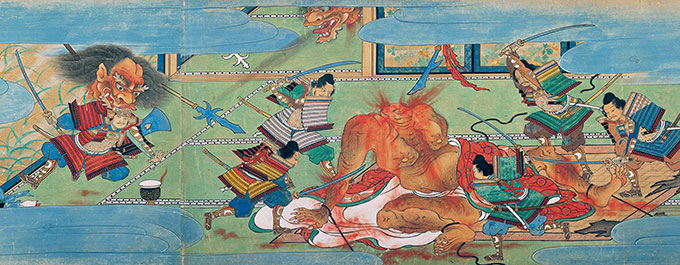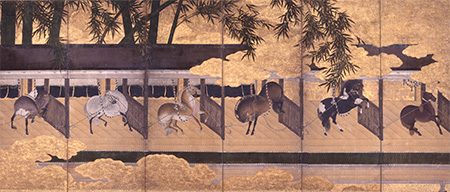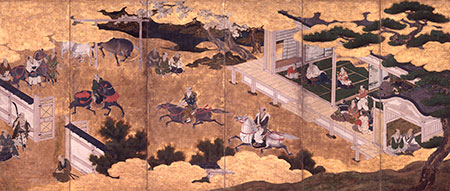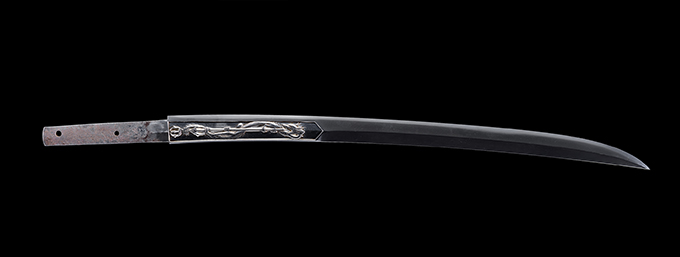- Calendar
- Online Ticket Sales
- Access
- JA
- EN
Suntory Museum of Art 60th Anniversary Exhibition
The Sword: The Soul of the Warrior
September 15 to October 31, 2021
*There will be an exhibition change during the course of exhibition.
*Download the list of changes in works on display
The list of changes in worksPDF
Chapter 1
Samurai in Paintings
Section 1:Battle Picture Scrolls and Paintings of War Chronicles
When we imagine warriors, we see them ready for battle. In The Zenkunen War and The Gosannen War, both picture scrolls from the Tokyo National Museum, and other depictions of battles from the middle ages, we see warriors, the group then gaining power and social influence, clad in full armor.
In paintings of the war chronicles, such as The Tale of the Heike, the warriors fight with swords, bows and arrows, and spears. These works include illustrations that display the sophisticated refinements made to improve swords’ performance in battle.
Section 2:Monogatari-e and Musha-e, Samurai in Action
These monogatari-e picture scrolls depict tales, monogatari, involving swords. In them, swords are depicted symbolically, along with the fierce warriors who wield them to exorcise evil spirits.
The Conquest of Shuten-dōji picture scroll in the Suntory Museum of Art collection is the work of the Muromachi-period painter Kanō Motonobu. In that tale of epic valor, Fujiwara no Yasumasa, Watanabe no Tsuna and the other three of the Four Guardian Kings are led into battle by the renowned warrior Minamoto no Yorimitsu (Raikō), wielding their swords to quell the demon Shuten-dōji. The series of scenes in this catalogue are intensely powerful images from that long epic. They are being shown for the first time since the picture scroll’s restoration after its designation as an Important Cultural Property.
In this section, images ranging from monogatari-e depicting tales of military actions in Japan’s middle ages to Edo period musha-e, ukiyo-e prints of warriors, allow us to explore the image of warriors and their swords.

Paintings by Kanō Motonobu, calligraphy by Konoe Hisamichi, Jōhōji Kōjo, Shōren’in Sonchin
Volume 3 (detail), Muromachi period, dated 1522, Suntory Museum of Art
【To be shown over an entire period】
Chapter 2
Armor, Weaponry and Sword Fittings
Section 1:Changes in Armor and Weaponry
The cuirass and helmet, the typical forms of Japanese armor, have under-gone historic transformations over the centuries. The cuirass has evolved from the ō-yoroi scale-covered armor worn by warriors from ancient times through the Genpei War (1180-85) in the middle ages, through the haramaki armor-plated cuirass and dōmaru, breastplate, to the tōsei-gusoku or “modern” armor of the early modern period. Picture scrolls depicting famous battles, together with folding screens, let us confirm these changes.
As armor changed, so did swords, sword fittings and other gear. These implements were magnificently decorated using state-of-the-art textile, lacquer, and metalwork techniques designed to convey the status of those who wore the armor and wielded the swords. These items convey the spirit of those who lived in each age.
Section 2:Samurai Customs—Images depicting the everyday lives of the samurai
During the Warring States period and other stages in Japan’s long history, there were times when samurai were in combat from morning to night. Yet their lives also had a more human side. As can be seen, for example, in the Training and Stabling Horses folding screen (Taga Taisha), besides training horses and practicing martial arts and the way of the sword, samurai also engaged in other, more mundane activities, having fun playing board games or enjoying the world of tea. In the sunny expressions of the samurai depicted in these images, we see another side of samurai hearts, quite different from when they were engaged in battle.
In paintings of various occupations, of which many examples were created in the early Edo period, we see the homes and workshops of armourers, arrow makers, and specialists in making horse tack, plus blade sharpeners and sword-guard makers.
The exquisite craftsmanship demonstrated by these gorgeous early modern period sword accessories, sword guards, and fittings not only speaks of the samurai aesthetic. It also communicates the realities of those whose craftsmanship supported the Japanese sword culture and the samurai way of life.

Left screen of a pair of six-panel folding screens, Muromachi period,
16th century-Early 17th century, Taga Taisya
【To be shown between Oct. 6 and Oct. 31】

Right screen of a pair of six-panel folding screens, Muromachi period,
16th century-Early 17th century, Taga Taisya
【To be shown between Oct. 6 and Oct. 31】
Chapter 3
Prayers Spoken in Steel—Blades from Ancient Shrines and Temples
Section 1:The Power to Dispel Evil Spirits—Swords Cherished and Handed Down
The sword is not just a weapon with which the samurai engages in battle with his enemies. Military epics from the middle ages tell us that people have long believed that the sword also embodies the spiritual authority to exorcise demons and monsters. Even more than as weapons used in battle, swords were prized as prayers for protection and peace. In this section, we introduce swords donated as offerings to historic Shinto shrines and venerated Buddhist temples, primarily in Kyoto. Many of these swords not only bear inscriptions that tell us who made them but also give the names of the emperors, nobles, priests, or warriors whose offerings they were. In this section, we reflect upon the donors’ prayers embodied in these swords and the traditions associated with them.
Section 2:Samurai and Swords—The Warrior’s Love of Famous Blades
Many swords survive in today’s world. Among them, famous swords said to carried by the Warring States generals who shaped their times stand out with special brilliance. Here you will find the renowned Hizamaru (Daikakuji Temple), a sword treasured by generations of the Minamoto clan, the Yoshimoto Samonji (Kenkun Shrine), taken by Oda Nobunaga from Imagawa Yoshimoto after defeating him in battle at Okehazama, and the Honebami Tōshirō (Toyokuni Shrine), associated with the Toyotomi clan. The fame of these swords idolized by samurai is timeless. Please take a thoughtful look at these renowned swords, each of which has been preserved and handed down throughout their heirs’ checkered histories.

Kamakura period, 13th century, Daikaku-ji Temple, Kyoto
【To be shown over an entire period】

Kamakura period, 13th century, Toyokuni Shrine, Kyoto
【To be shown over an entire period】
Section 3:Festivals and Swords—Kyoto’s Gion Festival
The Suntory Museum of Art collection includes the Hie Sannō Festival and Gion Festival folding screens from the Muromachi period and the Gion Festival folding screen, which was originally a fusuma-e (sliding door painting) produced in early Edo. Particularly noteworthy in these lively festival scenes are the Hashibenkeiyama and Jōmyōyama floats associated with samurai, and especially the magnificent Naginata Hoko float. That float’s dramatic appearance celebrates the importance of naginata, which cast out evil spirits, in the Gion Festival. In this section, visitors can see blades that had been displayed during the Gion Festival and the exhibit of swords donated to Yasaka Shrine in the Gion district and observe the connection between the festival events and swords that cast out evil spirits.
*Unauthorized reproduction or use of texts or images from this site is prohibited.
2024 January
- Exhibition
- Closed
- Tea Ceremony
- Mon
- Tue
- Wed
- Thu
- Fri
- Sat
- Sun
- 1
- 2
- 3
- 4
- 5
- 6
- 7
- 8
- 9
- 10
- 11
- 12
- 13
- 14
- 15
- 16
- 17
- 18
- 19
- 20
- 21
- 22
- 23
- 24
- 25
- 26
- 27
- 28
- 29
- 30
- 31
2024 February
- Exhibition
- Closed
- Tea Ceremony
- Mon
- Tue
- Wed
- Thu
- Fri
- Sat
- Sun
- 1
- 2
- 3
- 4
- 5
- 6
- 7
- 8
- 9
- 10
- 11
- 12
- 13
- 14
- 15
- 16
- 17
- 18
- 19
- 20
- 21
- 22
- 23
- 24
- 25
- 26
- 27
- 28
- 29
2024 March
- Exhibition
- Closed
- Tea Ceremony
- Mon
- Tue
- Wed
- Thu
- Fri
- Sat
- Sun
- 1
- 2
- 3
- 4
- 5
- 6
- 7
- 8
- 9
- 10
- 11
- 12
- 13
- 14
- 15
- 16
- 17
- 18
- 19
- 20
- 21
- 22
- 23
- 24
- 25
- 26
- 27
- 28
- 29
- 30
- 31
2024 April
- Exhibition
- Closed
- Tea Ceremony
- Mon
- Tue
- Wed
- Thu
- Fri
- Sat
- Sun
- 1
- 2
- 3
- 4
- 5
- 6
- 7
- 8
- 9
- 10
- 11
- 12
- 13
- 14
- 15
- 16
- 17
- 18
- 19
- 20
- 21
- 22
- 23
- 24
- 25
- 26
- 27
- 28
- 29
- 30
2024 May
- Exhibition
- Closed
- Tea Ceremony
- Mon
- Tue
- Wed
- Thu
- Fri
- Sat
- Sun
- 1
- 2
- 3
- 4
- 5
- 6
- 7
- 8
- 9
- 10
- 11
- 12
- 13
- 14
- 15
- 16
- 17
- 18
- 19
- 20
- 21
- 22
- 23
- 24
- 25
- 26
- 27
- 28
- 29
- 30
- 31
2024 June
- Exhibition
- Closed
- Tea Ceremony
- Mon
- Tue
- Wed
- Thu
- Fri
- Sat
- Sun
- 1
- 2
- 3
- 4
- 5
- 6
- 7
- 8
- 9
- 10
- 11
- 12
- 13
- 14
- 15
- 16
- 17
- 18
- 19
- 20
- 21
- 22
- 23
- 24
- 25
- 26
- 27
- 28
- 29
- 30
2024 July
- Exhibition
- Closed
- Tea Ceremony
- Mon
- Tue
- Wed
- Thu
- Fri
- Sat
- Sun
- 1
- 2
- 3
- 4
- 5
- 6
- 7
- 8
- 9
- 10
- 11
- 12
- 13
- 14
- 15
- 16
- 17
- 18
- 19
- 20
- 21
- 22
- 23
- 24
- 25
- 26
- 27
- 28
- 29
- 30
- 31
2024 August
- Exhibition
- Closed
- Tea Ceremony
- Mon
- Tue
- Wed
- Thu
- Fri
- Sat
- Sun
- 1
- 2
- 3
- 4
- 5
- 6
- 7
- 8
- 9
- 10
- 11
- 12
- 13
- 14
- 15
- 16
- 17
- 18
- 19
- 20
- 21
- 22
- 23
- 24
- 25
- 26
- 27
- 28
- 29
- 30
- 31
2024 September
- Exhibition
- Closed
- Tea Ceremony
- Mon
- Tue
- Wed
- Thu
- Fri
- Sat
- Sun
- 1
- 2
- 3
- 4
- 5
- 6
- 7
- 8
- 9
- 10
- 11
- 12
- 13
- 14
- 15
- 16
- 17
- 18
- 19
- 20
- 21
- 22
- 23
- 24
- 25
- 26
- 27
- 28
- 29
- 30
2024 October
- Exhibition
- Closed
- Tea Ceremony
- Mon
- Tue
- Wed
- Thu
- Fri
- Sat
- Sun
- 1
- 2
- 3
- 4
- 5
- 6
- 7
- 8
- 9
- 10
- 11
- 12
- 13
- 14
- 15
- 16
- 17
- 18
- 19
- 20
- 21
- 22
- 23
- 24
- 25
- 26
- 27
- 28
- 29
- 30
- 31
2024 November
- Exhibition
- Closed
- Tea Ceremony
- Mon
- Tue
- Wed
- Thu
- Fri
- Sat
- Sun
- 1
- 2
- 3
- 4
- 5
- 6
- 7
- 8
- 9
- 10
- 11
- 12
- 13
- 14
- 15
- 16
- 17
- 18
- 19
- 20
- 21
- 22
- 23
- 24
- 25
- 26
- 27
- 28
- 29
- 30
2024 December
- Exhibition
- Closed
- Tea Ceremony
- Mon
- Tue
- Wed
- Thu
- Fri
- Sat
- Sun
- 1
- 2
- 3
- 4
- 5
- 6
- 7
- 8
- 9
- 10
- 11
- 12
- 13
- 14
- 15
- 16
- 17
- 18
- 19
- 20
- 21
- 22
- 23
- 24
- 25
- 26
- 27
- 28
- 29
- 30
- 31
2025 January
- Exhibition
- Closed
- Tea Ceremony
- Mon
- Tue
- Wed
- Thu
- Fri
- Sat
- Sun
- 1
- 2
- 3
- 4
- 5
- 6
- 7
- 8
- 9
- 10
- 11
- 12
- 13
- 14
- 15
- 16
- 17
- 18
- 19
- 20
- 21
- 22
- 23
- 24
- 25
- 26
- 27
- 28
- 29
- 30
- 31
2025 February
- Exhibition
- Closed
- Tea Ceremony
- Mon
- Tue
- Wed
- Thu
- Fri
- Sat
- Sun
- 1
- 2
- 3
- 4
- 5
- 6
- 7
- 8
- 9
- 10
- 11
- 12
- 13
- 14
- 15
- 16
- 17
- 18
- 19
- 20
- 21
- 22
- 23
- 24
- 25
- 26
- 27
- 28
2025 March
- Exhibition
- Closed
- Tea Ceremony
- Mon
- Tue
- Wed
- Thu
- Fri
- Sat
- Sun
- 1
- 2
- 3
- 4
- 5
- 6
- 7
- 8
- 9
- 10
- 11
- 12
- 13
- 14
- 15
- 16
- 17
- 18
- 19
- 20
- 21
- 22
- 23
- 24
- 25
- 26
- 27
- 28
- 29
- 30
- 31
2025 April
- Exhibition
- Closed
- Tea Ceremony
- Mon
- Tue
- Wed
- Thu
- Fri
- Sat
- Sun
- 1
- 2
- 3
- 4
- 5
- 6
- 7
- 8
- 9
- 10
- 11
- 12
- 13
- 14
- 15
- 16
- 17
- 18
- 19
- 20
- 21
- 22
- 23
- 24
- 25
- 26
- 27
- 28
- 29
- 30
2025 May
- Exhibition
- Closed
- Tea Ceremony
- Mon
- Tue
- Wed
- Thu
- Fri
- Sat
- Sun
- 1
- 2
- 3
- 4
- 5
- 6
- 7
- 8
- 9
- 10
- 11
- 12
- 13
- 14
- 15
- 16
- 17
- 18
- 19
- 20
- 21
- 22
- 23
- 24
- 25
- 26
- 27
- 28
- 29
- 30
- 31
2025 June
- Exhibition
- Closed
- Tea Ceremony
- Mon
- Tue
- Wed
- Thu
- Fri
- Sat
- Sun
- 1
- 2
- 3
- 4
- 5
- 6
- 7
- 8
- 9
- 10
- 11
- 12
- 13
- 14
- 15
- 16
- 17
- 18
- 19
- 20
- 21
- 22
- 23
- 24
- 25
- 26
- 27
- 28
- 29
- 30
2025 July
- Exhibition
- Closed
- Tea Ceremony
- Mon
- Tue
- Wed
- Thu
- Fri
- Sat
- Sun
- 1
- 2
- 3
- 4
- 5
- 6
- 7
- 8
- 9
- 10
- 11
- 12
- 13
- 14
- 15
- 16
- 17
- 18
- 19
- 20
- 21
- 22
- 23
- 24
- 25
- 26
- 27
- 28
- 29
- 30
- 31
2025 August
- Exhibition
- Closed
- Tea Ceremony
- Mon
- Tue
- Wed
- Thu
- Fri
- Sat
- Sun
- 1
- 2
- 3
- 4
- 5
- 6
- 7
- 8
- 9
- 10
- 11
- 12
- 13
- 14
- 15
- 16
- 17
- 18
- 19
- 20
- 21
- 22
- 23
- 24
- 25
- 26
- 27
- 28
- 29
- 30
- 31
2025 September
- Exhibition
- Closed
- Tea Ceremony
- Mon
- Tue
- Wed
- Thu
- Fri
- Sat
- Sun
- 1
- 2
- 3
- 4
- 5
- 6
- 7
- 8
- 9
- 10
- 11
- 12
- 13
- 14
- 15
- 16
- 17
- 18
- 19
- 20
- 21
- 22
- 23
- 24
- 25
- 26
- 27
- 28
- 29
- 30
2025 October
- Exhibition
- Closed
- Tea Ceremony
- Mon
- Tue
- Wed
- Thu
- Fri
- Sat
- Sun
- 1
- 2
- 3
- 4
- 5
- 6
- 7
- 8
- 9
- 10
- 11
- 12
- 13
- 14
- 15
- 16
- 17
- 18
- 19
- 20
- 21
- 22
- 23
- 24
- 25
- 26
- 27
- 28
- 29
- 30
- 31
2025 November
- Exhibition
- Closed
- Tea Ceremony
- Mon
- Tue
- Wed
- Thu
- Fri
- Sat
- Sun
- 1
- 2
- 3
- 4
- 5
- 6
- 7
- 8
- 9
- 10
- 11
- 12
- 13
- 14
- 15
- 16
- 17
- 18
- 19
- 20
- 21
- 22
- 23
- 24
- 25
- 26
- 27
- 28
- 29
- 30
2025 December
- Exhibition
- Closed
- Tea Ceremony
- Mon
- Tue
- Wed
- Thu
- Fri
- Sat
- Sun
- 1
- 2
- 3
- 4
- 5
- 6
- 7
- 8
- 9
- 10
- 11
- 12
- 13
- 14
- 15
- 16
- 17
- 18
- 19
- 20
- 21
- 22
- 23
- 24
- 25
- 26
- 27
- 28
- 29
- 30
- 31
